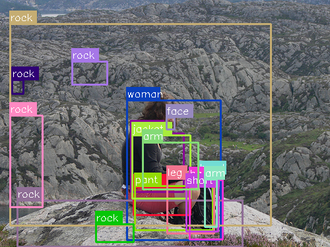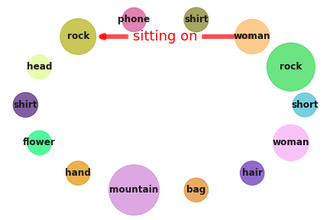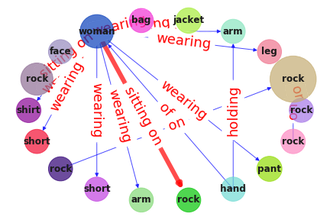| Object Detections | Ground truth Scene Graph | Generated Scene Graph |
|---|---|---|
 |
 |
 |
In this visualization, woman sitting on rock is a zero-shot triplet, which means that the combination of woman, sitting on and rock has never been observed during training. However, each of the object and predicate has been observed, but together with other objects and predicate. For example, woman sitting on chair has been observed and is not a zero-shot triplet. Making correct predictions for zero-shots is very challenging, so in our paper we address this problem and improve zero-shot as well as few-shot results.
This code accompanies our paper Boris Knyazev, Harm de Vries, Cătălina Cangea, Graham W. Taylor, Aaron Courville, Eugene Belilovsky. "Graph Density-Aware Losses for Novel Compositions in Scene Graph Generation"
To run our experiments we used amazing Rowan Zellers' code for Neural Motifs. Its only problem is the difficult to be run in PyTorch > 0.3, making it hard to use it on some recent GPUs.
So, in this repo, I provide a cleaned-up version that can be run in PyTorch 1.2 or later. The code is based on Mask R-CNN built-in in recent PyTorch. It should be possible to reproduce our GQA results using this code.
This code does not require building or manually downloading anything in advance. Training the Scene Graph Classification (SGCls) model with our loss on Visual Genome is as easy as running this command:
python main.py -data data_path -loss dnorm
The script will automatically download all data and create the following directories (make sure you have at least 30GB of disk space in data_path):
data_path
│ VG
│ │ VG.tar
│ │ VG_100K (this will appear after extracting VG.tar)
│ │ ...
│
└───GQA
│ │ GQA_scenegraphs.tar
│ │ sceneGraphs (this will appear after extracting GQA_scenegraphs.tar)
| | ...
To run it on GQA, use:
python main.py -data data_path -loss dnorm -split gqa -lr 0.002
Checkpoints and predictions will be saved locally in ./results. This can be changed by the -save_dir flag. See examples below.
This repository is still in progress, please report any issues.
- Python > 3.5
- PyTorch >= 1.2
- Other standard libraries
Should be enough to install these libraries (in addition to PyTorch):
conda install -c anaconda h5py cython dill pandas
conda install -c conda-forge pycocotools tqdm
Results in this repo were obtained on a single GPU 1080/2080 Ti, up to 11GB of GPU memory and 32GB of RAM was required.
- Message Passing with Mask R-CNN
- Automatically download all files required to run the code
- Obtain SGCls/PredCls results on VG and GQA
- Obtain SGGen results on VG and GQA
- Add trained checkpoints
- Add the code to visualize scene graph generation on GQA using the trained checkpoint
Results here are obtained using Mask R-CNN with ResNet-50 as a backbone, while in the paper we used Faster R-CNN with VGG16 as a backbone. We also skip a refinement step in this repo, which is usually required to improve SGGen results. Hence there's some difference in results from the paper. See full details in the paper.
| Loss | Detector | SGCls-R@100 | SGCls-R_ZS@100 | PredCls-R@50 | PredCls-R_ZS@50 |
|---|---|---|---|---|---|
| Baseline, this repo | Mask R-CNN (ResNet-50) pretrained on COCO | 47.1 | 7.8 | 74.5 | 23.5 |
| D-norm (ours), this repo‡ | Mask R-CNN (ResNet-50) pretrained on COCO | 47.4 | 9.0 | 75.4 | 27.3 |
| D-norm (ours), paper | Faster R-CNN (VGG16) pretrained on VG | 48.6 | 9.1 | 78.2 | 28.4 |
‡ Can be reproduced by running: python main.py -data data_path -loss dnorm -save_dir VG_sgcls
Or download our VG-SGCls-1 checkpoint
| Loss | Detector | SGGen-R@100 | SGGen-R_ZS@100 | SGGen-mR@100 |
|---|---|---|---|---|
| Baseline, this repo | Mask R-CNN (ResNet-50) pretrained on VG | 26.4 | 1.0 | 6.3 |
| D-norm (ours), this repo‡ | Mask R-CNN (ResNet-50) pretrained on VG | 26.5 | 1.4 | 9.5 |
| D-norm (ours), paper | Mask R-CNN (ResNet-50) pretrained on VG | 28.2 | 1.2 | 9.5 |
‡ Steps to reproduce the results above:
-
Fine-tune Mask R-CNN on VG:
python pretrain_detector.py stanford data_path ./pretrain_VG# takes about 1 day. Or download our VG-detector checkpoint -
Train SGCls:
python main.py -data data_path -loss dnorm -ckpt pretrain_VG/gqa_maskrcnn_res50fpn.pth -save_dir VG_sgdet# takes about 1 day. Or download our VG-SGCls-2 checkpoint. This checkpoint is different from VG-SGCls-1, because here the model is trained on the features of the VG-pretrained detector. This checkpoint can be used in the next step. -
Evaluate SGGen:
python main.py -data data_path -ckpt ./VG_sgdet/vgrel.pth -m sgdet -nepoch 0# takes a couple hours
In this repo, I am using a slightly different edge model in UnionBoxesAndFeats to avoid building code and simplify the pipeline. This can contribute to the difference. Using Neural Motifs's edge model should lead to more similar results.
| Loss | Detector | SGCls-R@100 | SGCls-R_ZS@100 | PredCls-R@50 | PredCls-R_ZS@50 |
|---|---|---|---|---|---|
| Baseline, this repo | Mask R-CNN (ResNet-50) pretrained on COCO | 27.1 | 2.9 | 58.4 | 33.1 |
| D-norm (ours), this repo‡ | Mask R-CNN (ResNet-50) pretrained on COCO | 27.4 | 3.1 | 59.6 | 36.0 |
| D-norm (ours), paper | Mask R-CNN (ResNet-50) pretrained on COCO | 27.6 | 3.0 | 61.0 | 37.2 |
‡ Can be reproduced by running: python main.py -data data_path -loss dnorm -split gqa -lr 0.002 -save_dir GQA_sgcls # takes about 1 day. Or download our GQA-SGCls-1 checkpoint
| Loss | Detector | SGGen-R@300 | SGGen-R_ZS@300 | SGGen-mR@300 |
|---|---|---|---|---|
| Baseline, this repo | Mask R-CNN (ResNet-50) pretrained on GQA | 6.2 | 0.5 | 1.3 |
| D-norm (ours), this repo‡ | Mask R-CNN (ResNet-50) pretrained on GQA | 6.3 | 0.7 | 2.4 |
| D-norm (ours), paper | Mask R-CNN (ResNet-50) pretrained on GQA | 4.6 | 0.4 | 2.0 |
‡ Steps to reproduce the results above:
-
Fine-tune Mask R-CNN on GQA:
python pretrain_detector.py gqa data_path ./pretrain_GQA# takes about 1 day. Or download our GQA-detector checkpoint -
Train SGCls:
python main.py -data data_path -lr 0.002 -split gqa -nosave -loss dnorm -ckpt pretrain_GQA/gqa_maskrcnn_res50fpn.pth -save_dir GQA_sgdet# takes about 1 day. Or download our GQA-SGCls-2 checkpoint. This checkpoint is different from SGCls-1, because here the model is trained on the features of the GQA-pretrained detector. This checkpoint can be used in the next step. -
Evaluate SGGen:
python main.py -data data_path -split gqa -ckpt ./GQA_sgdet/vgrel.pth -m sgdet -nosave -nepoch 0# takes a couple hours
Please use this bibtex if you want to cite our paper:
@inproceedings{knyazev2020graphdensity,
title={Graph Density-Aware Losses for Novel Compositions in Scene Graph Generation},
author={Knyazev, Boris and de Vries, Harm and Cangea, Cătălina and Taylor, Graham W and Courville, Aaron and Belilovsky, Eugene},
booktitle={British Machine Vision Conference (BMVC)},
pdf={http://arxiv.org/abs/2005.08230},
year={2020}
}